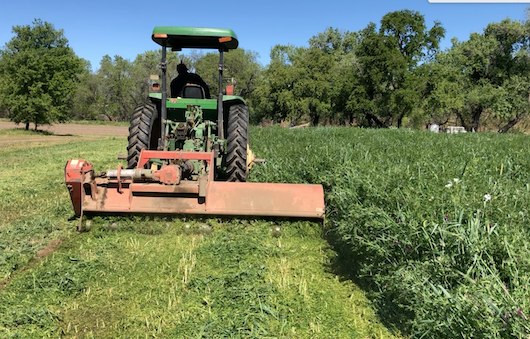
What a challenging time, navigating fears, isolation, suspension of touch and comfort-giving and millions of unemployed. Our Full Belly community sends hope that all of you are safe, strong and resilient. Dru and I shared a notion when we were parenting our 4 children and there was a particularly challenging moment: It was, “this too shall pass” – a small comfort, but generally more than true.
Springtime continues its relentless, beautiful demands on our attention. It is Sunday evening and the cacophony of birds singing and cooing in the trees outside my window remind me of the regularity and power of the natural systems underlying our place here. We are driven by the time of the season and continue to be busy planting melons, tomatoes, beans, corn, flowers and the crops that will become summertime’s harvest. A dry spring has meant water for irrigation is needed everywhere at the same time. Cover crops are being incorporated and their digestion by our soil microbes will become fertility for summer crops.
The days are full and overwhelming with the need to pick, trim and wash our crops each day. Trucks are leaving the farm full with more CSA boxes, produce for farmers markets, pallets of produce for wholesalers and mixed orders for more than 15 stores. Farmers Markets have been modified and have adapted to Covid19 protocols. Last week, pre-Mothers Day, we picked, bunched and delivered over 5000 bouquets of amazing flowers, cleaned and trimmed about the same number of bunches of garlic, onions, chard, asparagus and spring greens. Our crew has been great – dedicated, focused and attentive to their social distance and responsibility to the whole.
Lots to do – full days – great haymaking weather to bale and bring our winter feed into the barn. When a body is getting slower, touching the ground isn’t so hard, but straightening up is proving more difficult. There are only so many springs in a farmer’s life, and each is unique with its own set of challenges, and each gives different insight to the plan for resilience that farm design is built upon.
Growing up on a dairy farm in San Jose during the turbulent 50’s and 60’s, the farm economy was anything but resilient. It was a period of exodus from the land for many. Farms failed, and as a result, rural economies and towns were shuttered. Farms consolidated as neighbors bought out neighbors and packing and processing facilities were built to lower the per unit cost of everything from canned green beans to hamburger or chicken. The hardships of farm-life gave way to a food system design that mechanized and concentrated – it was get big or get out as Earl Butz famously said in the 1970’s. We are seeing that this system when looking at something like meat packing, may not be as resilient as was assumed. When Covid19 cases infect the meat packing plants there are incredible repercussions.
Today our meat packing plants are symbols of how efficiency has worked, and how vulnerable it has become. In the Midwest and the south there are millions of animals who must be destroyed because the plants that process them are closed because of Covid19. The processing plants are designed for velocity and efficiency as workers stand shoulder to shoulder to process beef, chicken and pork at breakneck speed. That workplace has been one of the most dangerous in the country for industrial accidents and now is the same for clusters of infections and death from the virus. Most of the workers in these plants are immigrants, paid minimum wage with few benefits. At one plant in Minnesota, 57 languages are spoken among the 1800 workers.
Slaughterhouses butcher 510,000 pigs a day in the U.S. Because the market, including exports, consumes that many hogs a day, another 510,000 will be ready for slaughter tomorrow, and the day after that, and the day after that. Any disruption in the processing of these animals results in a backlog of animals at the farm. Prices paid to farmers for beef, pork and chicken have plummeted as processing plants try to deal with worker safety. Much of the issue lies in the nature of the market itself. Processors continue to consolidate: today the 4 largest pork processors control 57% of all hogs marketed, and the 4 largest cattle packers process 80%of the market. Their model of efficiency and scale carries great risk for all involved.
We started farming organically in 1984 because of market concentration and the growing reality that the tools for farm solvency in the 50’s through the 90’s were increasingly toxic and dangerous. Equipment grew larger as farms sought to replace people with machinery. Land was leveled, edges of fields that were rich habitat for doves, pheasants or wildlife, were cleared and sprayed. The landscape was becoming increasingly toxic and sterile. There was little room for a rethinking or re-design as the victors – those who proved resilient – were those who could produce crops most cheaply. Those were the farmers who stayed in business in a system drowning in its own oversupply and cheap food. We sought, with many other small farmers to build another model.
It is a challenging time offering all a chance to do some rethinking about balance between health, economic structure and ones own interpretation of resilience. While not all farms will ever be like what we designed here, we can think of the power of decentralizing, economic democracy and policies that allow for the diversification of the marketplace in terms of producers, processors and how we make our consumption choices.
Enough then – rain may be coming. Do your rain dances this week and invite the heavy clouds in to nourish and feed the fields and forests. This too shall pass, but we have the opportunity to change and adapt as the storms pass over us. Thank you for your support.
— Paul Muller

